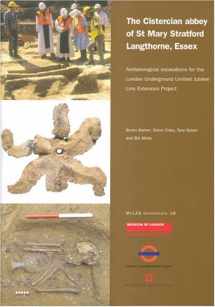
Cistercian abbey of St Mary Stratford Langthorne, Essex: Archaeological Excavations for the London Underground Limited Jubilee Line Extension Project (MoLA Monograph)
ISBN-13:
9781901992380
ISBN-10:
1901992381
Author:
Bill White, T. Dyson, Bruno Barber, Steve Chew
Publication date:
2004
Publisher:
MOLA (Museum of London Archaeology)
Format:
Paperback
198 pages
Category:
Churches & Church Leadership
,
Christian Books & Bibles
FREE US shipping
Book details
ISBN-13:
9781901992380
ISBN-10:
1901992381
Author:
Bill White, T. Dyson, Bruno Barber, Steve Chew
Publication date:
2004
Publisher:
MOLA (Museum of London Archaeology)
Format:
Paperback
198 pages
Category:
Churches & Church Leadership
,
Christian Books & Bibles
Summary
Cistercian abbey of St Mary Stratford Langthorne, Essex: Archaeological Excavations for the London Underground Limited Jubilee Line Extension Project (MoLA Monograph) (ISBN-13: 9781901992380 and ISBN-10: 1901992381), written by authors
Bill White, T. Dyson, Bruno Barber, Steve Chew, was published by MOLA (Museum of London Archaeology) in 2004.
With an overall rating of 3.6 stars, it's a notable title among other
Churches & Church Leadership
(Christian Books & Bibles) books. You can easily purchase or rent Cistercian abbey of St Mary Stratford Langthorne, Essex: Archaeological Excavations for the London Underground Limited Jubilee Line Extension Project (MoLA Monograph) (Paperback) from BooksRun,
along with many other new and used
Churches & Church Leadership
books
and textbooks.
And, if you're looking to sell your copy, our current buyback offer is $0.3.
Description
The Cistercian monastery of St Mary Stratford Langthorne once stood on land south of the new Jubilee Line station at Stratford. Excavations 1973-94 recorded large parts of the monastic church, cemetery and related buildings. Topics include the precinct arrangement, architecture and decoration, and the way of life of the inhabitants. The expansion of the monastic church from a simple cruciform building in the mid 12th century into an aisled presbytery with ambulatory and eastern chapel in the 13th century is notable. The excavated burials (647) are the largest sample from a Cistercian site in Europe and provide evidence for burial customs, patterns of cemetery use and the physical characteristics of the population, including medical care.


We would LOVE it if you could help us and other readers by reviewing the book
Book review

Congratulations! We have received your book review.
{user}
{createdAt}
by {truncated_author}


